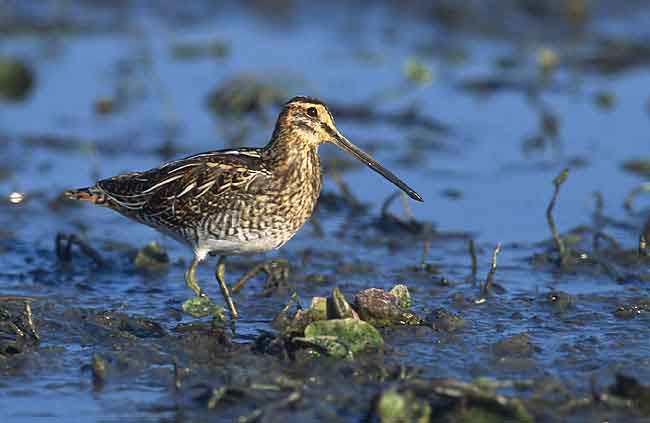Gallinago gallinago (*) Cladus: Eukaryota Name Gallinago gallinago (Linnaeus, 1758) Reference Systema Naturae ed.10 p.147 Vernacular names The Common Snipe (Gallinago gallinago) is a small, stocky wader native to the Old World. The breeding habitat is marshes, bogs, tundra and wet meadows throughout northern Europe and northern Asia. It is migratory, with European birds wintering in southern and western Europe and Africa (south to the Equator), and Asian migrants moving to tropical southern Asia.
It is the most widespread of several similar snipes. It most closely resembles the Wilson's Snipe G. delicata of North America, which was until recently considered to be a subspecies G. g. delicata of Common Snipe. They differ in the number of tail feathers, with seven pairs in G. gallinago and eight pairs in G. delicata; the North American species also has a slightly wider white edge to the wings.[4][5] Both species breed in the Aleutian Islands.[2] It is also very similar to the Pintail Snipe G. stenura and Swinhoe's Snipe G. megala of eastern Asia; identification of these species there is complex.[6] There are two subspecies of Common Snipe, G. g. faeroeensis in Iceland, the Faroes, Shetland and Orkney (wintering in Britain and Ireland), and G. g. gallinago in the rest of the Old World. Ecology It is a well camouflaged bird is usually shy and conceals itself close to ground vegetation and flushes only when approached closely. When flushed, they utter a sharp note that sounds like scape, scape and fly off in a series of aerial zig-zags to confuse predators.[7] They forage in soft mud, probing or picking up food by sight. They mainly eat insects and earthworms, also some plant material.[3] The male performs "winnowing" display during courtship, flying high in circles and then taking shallow dives to produce a "drumming" sound by vibrating its tail feathers. This sound has been compared by others to the bleating of a sheep or goat; hence in many languages the Snipe is known by names signifying “Flying Goat,” “Heaven's Ram,” as in Scotland by “Heather-bleater”[7] and in Finnish the name taivaanvuohi, "sky goat". Common Snipe nest in a well-hidden location on the ground, laying four eggs of a dark olive colour, blotched and spotted with rich brown,[7] which are incubated by the female for 18–21 days. The young when freshly hatched are covered in down of a dark maroon, variegated with black, white and buff.[7] The young are cared for by both parents, each parent looking after half the brood, with fledging in 10–20 days.[2][3] Conservation Overall, the species is not threatened. Populations on the southern fringes of the breeding range in Europe are however declining with local extinction in some areas (notably in parts of England and Germany), mainly due to field drainage and agricultural intensification.[2] The Agreement on the Conservation of African-Eurasian Migratory Waterbirds (AEWA) applies to the species. It is still hunted as a gamebird in much of its range.[2] History Old folk names include "mire snipe", "horse gowk", "heather bleat", and the variant spelling "snite".[8] See also snipe for other aspects of the name. References 1. ^ BirdLife International (2005). Gallinago gallinago. 2006. IUCN Red List of Threatened Species. IUCN 2006. www.iucnredlist.org. Retrieved on 12 May 2006. Database entry includes justification for why this species is of least concern Source: Wikipedia, Wikispecies: All text is available under the terms of the GNU Free Documentation License |
|

